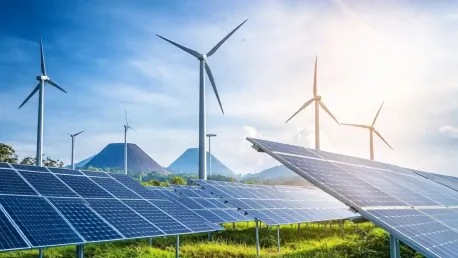The imperative role that central banks must play in facilitating the global shift from fossil fuels to renewable energy cannot be understated. As the climate crisis evolves beyond an environmental issue, it poses significant threats to financial stability, urging central banks, particularly in developed nations, to leverage their economic capabilities for climate action. By harnessing their extensive influence, these financial institutions can drive the necessary changes to promote sustainable energy practices and ensure economic resilience.
Understanding the Risks and Opportunities
The Role of Central Banks in Financial Stability
Climate-related risks are widely recognized by institutions like the Network for Greening the Financial System. These risks extend beyond environmental impacts, creating profound challenges for the stability of financial systems globally. Central banks in affluent countries, wielding control over global reserve currencies, are uniquely positioned to influence the financial response to climate change. Their ability to set monetary policies and provide funding can significantly impact investment trends, potentially steering capital away from harmful fossil fuel projects and towards sustainable alternatives.
Despite their capacity, central banks have not fully harnessed their power to combat climate change. While there is growing acknowledgment of the risks associated with climate change, concrete actions to drive large-scale shifts in financial practices remain limited. Addressing this gap requires central banks to adopt a more proactive stance, utilizing their influence to create a resilient and sustainable economic future. This includes regulating and incentivizing financial activities that support renewable energy initiatives, ultimately helping to mitigate climate-related risks and enhance overall economic stability.
Transitioning to Renewable Energy
Beyond acknowledging the risks of transitioning to renewable energy, central banks need to proactively drive solutions that ensure a smooth and effective shift. The transition involves complex challenges, including the need for substantial investments in renewable technologies and infrastructural developments. Central banks must limit financial support for fossil fuels and facilitate renewable energy investments, particularly in developing countries where financial gaps hinder progress. By channeling funds away from fossil fuel projects and towards clean energy solutions, central banks can help to accelerate the global transition.
Developing countries face unique hurdles, including limited access to affordable financing and heightened vulnerability to climate impacts. Central banks, in collaboration with development finance institutions (DFIs), can play a pivotal role in addressing these barriers. By providing targeted support and fostering conducive investment environments, central banks can help bridge financial gaps and promote sustainable energy practices. This strategic approach not only accelerates the adoption of renewable energy but also ensures that the transition is inclusive and equitable, benefiting all nations.
Strategic Initiatives for Energy Transition
Climate-TLTROs for Long-term Investment
Central banks can adapt existing targeted long-term refinancing operations (TLTROs) with a green variation to support climate investments. Climate-TLTROs would provide ultra-long-term, low-interest or interest-free loans to development finance institutions (DFIs) for climate investments, allowing DFIs to offer grants and concessional lending. These loans, designed to support sustainable projects, would empower DFIs to finance impactful climate initiatives, driving greater investment in renewable energy sectors. This innovative financial solution can significantly enhance the availability of funding for critical activities required to combat the climate crisis.
Development finance institutions, unlike commercial banks, focus on public development rather than profit maximization. This long-term, mission-driven approach aligns well with the extended time scales required for effective climate action. By securing Climate-TLTROs, DFIs can prioritize projects that deliver substantial environmental benefits, addressing both immediate and future needs. Central banks would recognize these loans as permanent assets on their balance sheets, reflecting the enduring nature of climate challenges. This measure would signal a strong commitment to sustainability, encouraging broader financial sector engagements in green investments.
De-risking Renewable Energy in the Global South
To overcome investment barriers in renewable energy projects, particularly in the global south, central banks can back guarantees for these investments. This would reduce perceived risks, attract private capital, and make renewable projects low-risk, leading to lower interest rates and cheaper renewable energy. Guaranteeing investments can transform the financial landscape, making renewable energy ventures more appealing to institutional investors. This approach can help to tap into significant financial resources that have traditionally been hesitant to engage in high-risk markets, fostering growth in sustainable energy infrastructure.
Partnerships between central banks and DFIs can develop comprehensive risk assessment frameworks, ensuring efficient allocation of guarantees. By mitigating risks associated with renewable energy projects, these guarantees facilitate smoother project implementation and enhance overall investor confidence. Reduced financial risks lead to more competitive financing options and increased investment inflows, ultimately driving down the cost of renewable energy production. This strategy aligns with the United Nations’ sustainable development goal of affordable and clean energy for all, promoting global energy equity and sustainable growth.
Innovative Financial Instruments
Convertible Climate Bonds
As a transition strategy for companies burdened with fossil fuel assets, central banks could buy convertible climate bonds from DFIs. This allows DFIs to purchase potentially stranded fossil fuel assets, provided that companies submit plans to invest in new renewable energies, thus facilitating a smoother transition. Convertible climate bonds offer a viable exit strategy for companies, enabling them to divest from harmful practices while committing to sustainable energy investments. This mechanism ensures that companies actively participate in the renewable transition, leveraging their existing assets to foster positive environmental outcomes.
Central banks, by purchasing these bonds, provide crucial financial support for the transition process, ensuring stability and encouraging corporate responsibility. The DFIs can then bundle acquired assets into new climate bonds, selling them back to central banks to generate funds for additional renewable energy projects. This cycle of investment transforms stranded assets into productive resources, accelerating the shift to sustainable energy systems. Climate bonds create a structured and incentivized pathway for companies and investors alike, fostering long-term environmental and economic benefits.
Long-term Commitment to Sustainability
The critical role of central banks in driving the global transition from fossil fuels to renewable energy cannot be overstated. As the climate crisis moves beyond a mere environmental concern, it now poses serious threats to financial stability, urging central banks, especially those in developed countries, to use their economic power to tackle climate change. With their vast influence, these financial institutions can implement crucial changes to support sustainable energy initiatives and ensure economic resilience. Central banks can develop policies that encourage renewable energy investments, offer green bonds, and incentivize banks and businesses to go green. They can set regulations that make fossil fuel investments less attractive while providing favorable conditions for renewable energy projects. By pushing for these transformations, central banks contribute not only to environmental sustainability but also to safeguarding future economic stability. Their actions are essential for promoting sustainable development and long-term economic health in the face of a worsening climate crisis.









